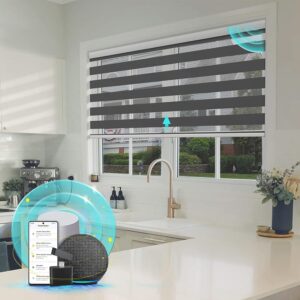Revolutionize your home with smart blinds
Discover the endless possibilities of smart blinds installation
Upgrade your living space with cutting-edge technology
Welcome to the world of smart blinds installation options
Transform your home into a smart haven with these installation choices
Wired Installation: The Traditional Approach
When it comes to installing smart blinds, one of the most common options is the wired installation. This traditional approach involves connecting the blinds to a power source and a control panel through a series of wires. The wired installation provides a reliable and stable connection, ensuring smooth operation of your smart blinds.
Benefits of Wired Installation
There are several benefits to opting for a wired installation for your smart blinds. Firstly, it eliminates the need for batteries, ensuring that your blinds will always have power. This is particularly useful for larger windows or areas where frequent battery changes would be inconvenient. Additionally, a wired installation allows for seamless integration with other smart home devices, such as voice assistants or home automation systems.
Considerations for Wired Installation
While a wired installation offers numerous advantages, there are a few considerations to keep in mind. Firstly, the installation process can be more complex and time-consuming compared to other options. It may require the assistance of a professional electrician to ensure proper wiring and connection. Additionally, if you are renting your home or prefer not to make permanent changes, a wired installation may not be the most suitable choice.
Wireless Installation: The Convenient Alternative
For those seeking a more convenient and flexible installation option, wireless installation is an excellent choice. With wireless smart blinds, you can enjoy the benefits of automation without the need for extensive wiring. Instead, these blinds are powered by batteries or rechargeable options, making them easy to install and move around your home.
Advantages of Wireless Installation
Wireless installation offers several advantages that make it an attractive option for many homeowners. Firstly, it provides greater flexibility in terms of blind placement, as you are not limited by the availability of power outlets or wiring. This is especially beneficial for renters or those who frequently rearrange their living spaces. Additionally, wireless smart blinds are often more affordable and easier to install, requiring minimal technical expertise.
Considerations for Wireless Installation
While wireless installation offers convenience, there are a few factors to consider. Firstly, you will need to ensure that the batteries or rechargeable options are regularly maintained and replaced to prevent any disruptions in functionality. Additionally, wireless smart blinds may have a limited range for remote control or voice commands, depending on the technology used. It is essential to consider the compatibility with your existing smart home ecosystem before opting for wireless installation.

Solar-Powered Installation: Harnessing the Power of the Sun
In recent years, solar-powered smart blinds have gained popularity as an eco-friendly and energy-efficient installation option. These blinds are equipped with solar panels that convert sunlight into electricity, eliminating the need for batteries or wired connections. Let’s explore the benefits and considerations of solar-powered smart blinds.
Advantages of Solar-Powered Installation
The use of solar power for smart blinds offers several advantages. Firstly, it reduces your reliance on traditional power sources, resulting in cost savings and a reduced carbon footprint. Solar-powered blinds are also independent of electrical outlets, providing greater flexibility in blind placement. Moreover, these blinds often come with built-in sensors that can automatically adjust the blinds based on the amount of sunlight, optimizing energy efficiency and enhancing your comfort.
Considerations for Solar-Powered Installation
While solar-powered smart blinds have numerous benefits, there are a few considerations to keep in mind. Firstly, the effectiveness of solar panels depends on the availability of sunlight in your location. If your windows are often shaded or if you live in an area with limited sunlight, the performance of solar-powered blinds may be compromised. Additionally, the initial cost of solar-powered blinds may be higher compared to other options, although the long-term energy savings can offset this investment.
Battery-Powered Installation: Flexibility and Convenience
Another popular installation option for smart blinds is the battery-powered approach. With this option, the blinds are powered by replaceable batteries, providing convenience and flexibility. Let’s delve into the benefits and considerations of battery-powered smart blinds.
Advantages of Battery-Powered Installation
Battery-powered smart blinds offer several advantages that make them a practical choice for many homeowners. Firstly, they are easy to install and require minimal wiring, making them a suitable option for both homeowners and renters. Additionally, battery-powered blinds offer flexibility in terms of blind placement, as they are not limited by the availability of power outlets. Furthermore, advancements in battery technology have led to longer battery life, reducing the frequency of replacements.
Considerations for Battery-Powered Installation
While battery-powered smart blinds offer convenience, there are a few considerations to keep in mind. Firstly, you will need to regularly monitor and replace the batteries to ensure uninterrupted functionality. This can be particularly important if you have multiple blinds or large windows. Additionally, the cost of purchasing and replacing batteries over time should be factored into your decision. It is also worth noting that battery-powered blinds may not be as energy-efficient as other options, depending on the type of batteries used.
Motorized Installation: Embrace the Convenience of Automation
Motorized smart blinds offer a high level of convenience and automation, allowing you to control your blinds with the touch of a button or through voice commands. Let’s explore the benefits and considerations of motorized smart blinds.
Advantages of Motorized Installation
Motorized smart blinds bring numerous advantages to your home. Firstly, they provide effortless control, allowing you to adjust the blinds remotely or set schedules for automatic operation. This is particularly useful for hard-to-reach windows or for individuals with mobility challenges. Motorized blinds also offer enhanced safety, as there are no cords or chains that pose a risk, making them a great choice for households with children or pets. Additionally, motorized blinds can be integrated with your existing smart home ecosystem, enabling seamless control through voice assistants or home automation systems.
Considerations for Motorized Installation
While motorized smart blinds offer convenience, there are a few considerations to keep in mind. Firstly, the installation process may require professional assistance, as it involves electrical wiring and motor integration. This can add to the overall cost of the blinds. Additionally, motorized blinds typically require a power source, either through a wired connection or rechargeable batteries. It is important to ensure that the power source is easily accessible and can support the operation of the blinds.
Hybrid Installation: Combining the Best of Both Worlds
If you’re looking for a versatile installation option, a hybrid approach might be the perfect fit. Hybrid smart blinds combine different installation methods, such as wired and wireless or motorized and battery-powered, to offer a customizable solution. Let’s explore the benefits and considerations of hybrid smart blinds.
Advantages of Hybrid Installation
Hybrid smart blinds provide the flexibility to tailor the installation to your specific needs. For example, you can have wired blinds in rooms where a stable power source is available, while opting for wireless or battery-powered blinds in other areas. This allows you to strike a balance between reliability, convenience, and cost-effectiveness. Hybrid blinds also offer the opportunity to gradually upgrade your home, starting with one installation method and expanding to others as desired.
Considerations for Hybrid Installation
While hybrid smart blinds offer versatility, there are a few considerations to keep in mind. Firstly, the complexity of the installation may vary depending on the combination of methods chosen. It is important to plan and coordinate the different components to ensure seamless operation. Additionally, the cost of a hybrid installation may be higher compared to choosing a single method. However, the ability to customize the installation to suit your specific requirements can outweigh the initial investment.
In conclusion, the world of smart blinds installation offers a wide range of options to suit every homeowner’s needs and preferences. Whether you opt for the traditional wired installation, the convenience of wireless blinds, the eco-friendliness of solar-powered blinds, the flexibility of battery-powered blinds, the automation of motorized blinds, or the versatility of hybrid blinds, there is a solution that will transform your living space into a smart haven.
Each installation option comes with its own set of advantages and considerations. Wired installation provides a reliable and stable connection, eliminating the need for batteries and allowing seamless integration with other smart home devices. Wireless installation offers flexibility and ease of installation, making it a suitable choice for renters or those who prefer not to make permanent changes. Solar-powered blinds harness the power of the sun, reducing reliance on traditional power sources and offering energy efficiency. Battery-powered blinds provide convenience and flexibility, requiring minimal wiring and offering longer battery life. Motorized blinds bring automation and effortless control, enhancing safety and integration with existing smart home systems. Hybrid blinds combine different installation methods, allowing for customization and gradual upgrades.
When choosing the right installation option for your smart blinds, it is essential to consider factors such as power source availability, ease of installation, maintenance requirements, compatibility with existing smart home devices, and long-term cost implications. By carefully evaluating these factors and understanding your specific needs, you can make an informed decision that will enhance your home’s functionality, energy efficiency, and overall aesthetic appeal.
So, why settle for ordinary blinds when you can embrace the convenience, energy efficiency, and automation of smart blinds? Isn’t it time to transform your home into a smart haven?

Smart thermostats have revolutionized energy efficiency in homes by allowing homeowners to automate and control their home’s climate with ease. These innovative devices use advanced technology to learn and adapt to your preferences, optimizing energy usage and reducing utility costs. With features like remote control, scheduling, and integration with smart home ecosystems, smart thermostats provide a seamless and convenient way to manage your home’s temperature.





